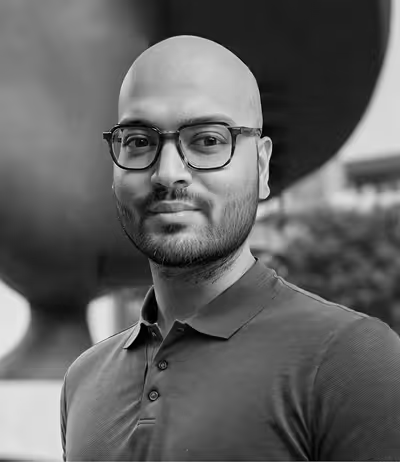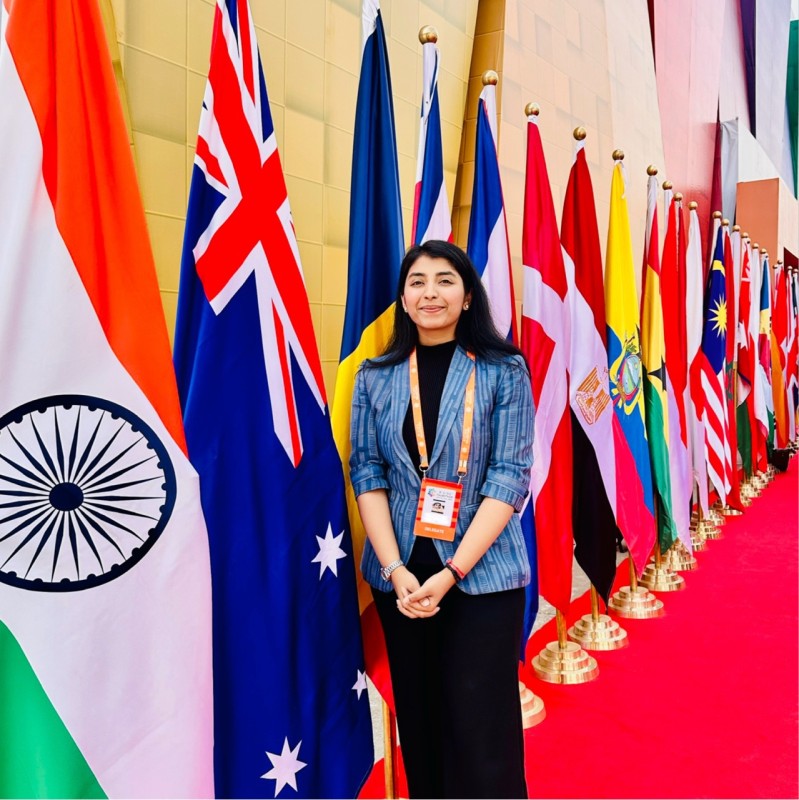How Malvika Agarwal Built Chal Shoes: A Gender-Neutral, Sustainable Fashion Brand
Malvika opens up about her creative journey, how she built Chal from the ground up, what drives her commitment to conscious fashion, and how her design thinking shapes her role at GA Infra.
How Malvika Agarwal Built Chal Shoes: A Gender-Neutral, Sustainable Fashion Brand
Malvika opens up about her creative journey, how she built Chal from the ground up, what drives her commitment to conscious fashion, and how her design thinking shapes her role at GA Infra.
A seasoned growth marketer who has worked with marquee B2B and B2C brands, including some Fortune 500s. He brings to the table in-depth knowledge of martech, B2B growth strategies, and digital marketing. Heloves to cook, brew coffee, travel, read, and meet new people.
Malvika Agarwal founded Chal with the intention of creating shoes she couldn't find in the Indian contemporary sector. High craftsmanship with indigenous techniques of construction and materials. A vision was conceived to design functionally refined pieces to exist in the space between progressive contemporary and nonchalance Indian maximalist design. From her first collection for schonfilt, Agarwal has seen a natural evolution in the way she approaches the whole process, from hand woven and upcycled fabrics to premium ethically sourced leather, to creating a confident product that is not just quietly refined but also functional. The broader vision is to design for a community that does not conform to gender norms and enables the person to have movement at ease!
Watch this episode and learn:
Read the transcript
Swapnil
People need to find the shoes that they want. What was the concept behind Chal Shoes? Did you have something specific in mind - that this is the brand I want to create in the Indian market?
You don’t really have a lot of options here. And you don’t have many specifically for workwear. For me, I really want the customer to understand what they like.
You’re running this show in what is now an almost 20-billion-dollar industry in India. And there are three very important items in your life that you should invest in - a good bed, a good office chair, and a good pair of shoes.
There was a time when the Indian market was flooded with global brands. How are you managing that now? How are you making sure you stand out from the crowd?
Also - thank you so much for joining us today, Malvika. This is something we’ve been wanting to do for a long time. We’ve been trying to fix a date, but it’s taken a while to get here. So thank you for making the time.
Malvika:
Thank you for having me. Sure - I'm Malvika. I was born in Sojat, a small town, then went to boarding school, then Jaipur, and eventually to the US. So I’ve seen all kinds of lives - from slow living in India to the independent pace of life in the US.
That contrast has really shaped who I am. I run a shoe business now, and I also work on buildings of some sort.
Swapnil
A real estate mogul in the making?
Malvika (laughs):
Not really, but I try what I can.
Swapnil
That’s what we’re here to talk about today - on the “Click to Know More” podcast by Nine Degree. We speak to entrepreneurs, both seasoned and emerging, and explore the role marketing plays in their journey. And I’m really looking forward to this conversation with you.
Malvika:
Yes! Marketing is definitely important for day-to-day sales.
Swapnil
So the first time I saw your shoes, a dear friend of ours - Shikha - was wearing them. She came over to my house in those shoes with the toe-split design… the tabby.
I was intrigued. I asked her what they were, and she just said, “These are the most comfortable shoes I’ve ever worn.” She kept raving about them.
And when I asked where she got them, she said, “My friend Malvika makes them.” I still remember that pair - indigo, almost Ikat-like, but not exactly.
Malvika:
Yes! That was indigo, made from upcycled fabric. We collaborated with a brand for that.
Swapnil
Right. Since then, I’ve gotten to know your company a little better, and it’s amazing to see how far you’ve come. You’re building this brand from scratch in a massive, competitive industry - without any prior experience, and with a family background in a completely different industry.
Malvika:
Yeah, nobody in my family is in retail. They were supportive, of course, but also confused - like, how are you going to do this?
There was no product-making or market-selling background around me. I was figuring it all out from scratch.
Swapnil
Since I already know a bit about Chal Shoes, why don’t you tell everyone - what exactly is Chal Shoes?
Malvika:
Honestly, I didn’t grow up with a specific passion. I studied architecture and industrial design in college. I was still figuring out what I liked.
Then in my third year, I realized I had always been spending all my money on shoes. So I took a shoe design class. And while I was making shoes in that class - I didn’t care about anything else. I was just in my zone, listening to music, creating shoes.
It was therapeutic. At that time, I didn’t think I’d make it a career. But after I graduated, I moved back to India to be closer to my parents. And my dad said, “Let’s just register a business.”
That was in December 2019. Around then, COVID was just starting.
Swapnil
So this was just before the pandemic?
Malvika:
Yes. I was also working with organizations like Creative Dignity and Hand for Handmade, helping artisans sell online. That’s how I met some shoemakers. One of them asked me to make shoes for Rajasthali, and we did.
And since then - it’s been all about shoes.
Swapnil
And you’re doing this in a very price-sensitive, competitive space. Global brands, indie brands, new names coming up every day - Nicobar, Theatre, OCD, Comet, Neemans. How do you stand out?
Malvika:
I wanted to design for people who are working from day to night. People who want to look put together, but also need comfort.
Since I was starting in 2020, sustainability was a must. But I didn’t think much about the market or trends. I probably should have - my first collection was all blue!
We were just experimenting - offering different silhouettes to let people discover what works for them.
Everyone’s feet are different. I personally prefer shoes that wrap around the toe for a secure fit. But others like open styles, lace-ups, slip-ons. We spent the first two years researching how Indians actually use shoes.
Most brands chase trends. I wanted customers to discover what they truly like. Not everyone needs to follow the same fashion cues.
Swapnil
And you also cater to foot types - bunion issues, flat feet, high arches?
Malvika:
Yes! We’re still working on it, but that’s the goal. People also ask for customizations. They send us photos, but we don’t copy. We’ll adapt something we’ve already made if it suits their preference.
Swapnil
Tell us what a bunion is - for those who may not know?
Malvika:
It’s when your big toe pushes outwards - there’s a bump. It can be really painful, often caused by wearing pointy shoes or high heels for too long. It’s common in women.
Swapnil
So when you're designing shoes, it’s not just about looks. You have to understand foot anatomy too?
Malvika:
Exactly. We started with sketching feet in class - for two weeks! We studied the shape, the way it moves. There’s so much that goes into designing around that.
Swapnil
So coming back to Chal Shoes - was there a clear concept in your head from the start? Or did you figure it out along the way?
Malvika:
Honestly, I was just looking for shoes I couldn’t find myself.
When I moved to the US, there were warehouses full of options. You could walk in, pick your style, your size - it felt personal. But in India, the market was limited. Especially for workwear.
Now, sneakers are trendy and people wear them to work, but not everyone wants that. I didn’t want kitten heels either. I wanted something powerful and comfortable.
That’s why I designed Oxford. It has a slight wedge - enough lift to feel confident, but it doesn’t hurt your feet. That was the idea. Shoes that make you feel like you own your space.
Because if your shoes are uncomfortable, they ruin your day. And you’re right - people wear their shoes from morning to night. They work in them. Some even sleep in them!
Swapnil
You also contribute to your family business, GA Infra, right?
Malvika:
Yes. My dad started GA Infra around the time I was born, so the company is as old as I am. I wasn’t involved early on, but after I moved back, I started helping with small things - making the website, checking how the office runs.
My dad handles large water infrastructure projects and doesn't have time for the design or communication side. That’s where I came in.
Eventually, when we started a building project of our own - not for the government - I got more involved. I was just reviewing architectural plans with my younger brother, making notes, learning how to read floor plans and electrical layouts.
One day my Dad and chachu (uncle) said, “Why don’t you manage the whole building?”
I was shocked. I had never led a construction project before. But they believed I could do it. So I started visiting the site every day, working with the team, observing labor, and doing R&D - especially on the facade.
I didn’t want glass facades. They don’t suit our climate and increase energy costs. Our office is red brick, so I used that as a base. Eventually, we switched to glazed brick - it has the look, but solves the water absorption issue.
That’s how I brought design thinking into our projects - making small changes that improve systems, even if the government doesn’t require them. Because real estate impacts how people live, move, and interact. It’s powerful.
Swapnil
That’s true - real estate is a huge canvas. But let’s shift back to footwear. If someone wanted to start a shoe brand today, how would you suggest they begin?
Malvika:
Start small. Test the waters. Use as little capital as possible at first.
You can spend any amount on marketing, but that doesn’t guarantee love for your product. You have to create something people love - and then sell it. Not the other way around.
Product validation is key. Build what people want before scaling.
Swapnil
So what goes into making a pair of Chal Shoes? Are you involved in production? Is anything outsourced?
Malvika:
We don’t have in-house shoemakers. I used to do R&D myself - visiting factories in Agra, Delhi, and even local clusters like Jawaja. That went on for six to seven months.
Most large manufacturers only work at scale, which is tough when you're starting out. So I created a chain: I source the material, get it custom-made, and then we work with artisans - including refugee women trained in embroidery.
Then we send it to the shoemaker. Some soles we make ourselves from used tires. I literally go to garages, pick out flexible tires, get them cut and cleaned, and then send them with all components to the shoemaker.
Design, sourcing, packaging - all of that happens in-house. And to stay sustainable, we make everything to order. The customer gets their shoe in 2–3 weeks. It's slower, but more thoughtful.
Swapnil
Is that model profitable?
Malvika:
Margins are low for now. But most of our customers come back - they order more of the same shoe in different colors. That repeat love keeps us going.
Swapnil
That makes sense. And as we discussed earlier - customers today are more conscious about what they’re buying and how they style themselves.
Which reminds me - you mentioned that stylists and even celebrities are now sourcing from you. Tell us more!
Malvika:
Yes! Stylists from Bombay have reached out. Sonam Kapoor’s team. Manisha Melwani. Even Guneet Monga wore our shoes the day after she won her Oscar.
Her stylist was curating her LA wardrobe and wanted something unique. That was our first real sourcing request - and it was completely organic. We had no idea she’d win the Oscar!
Swapnil
That’s huge! Your shoes are literally traveling the world. How does that feel?
Malvika:
It’s validating. But honestly, I feel more joy when people wear them every day - like Shikha. She wears them because she loves them, not to support me. That’s what matters.
Swapnil
Let’s talk about marketing. Does a good product sell itself?
Malvika:
No, it doesn’t.
Swapnil
So how are you marketing Chal Shoes? What’s working for you? What channels or strategies have helped build the brand?
Malvika:
Our brand story was always there - on the website, on our packaging. And a few connoisseurs - people who really care about craft and quality - found us that way. That’s what I had learned at IIM as well: build for the connoisseurs.
But connoisseurs only make up 10% of your business. The remaining 90% follow because they aspire to be like them. So visibility becomes really important.
We recently started working with a marketing agency. I was very hesitant at first. I kept thinking, "I don’t want to spend money on ads - I’d rather use it for product development." And for two years, that’s what I did.
But once we started marketing, I realized something crucial: most people haven’t seen your product. You think they’re seeing it and rejecting it - but they haven’t even seen it. Your Instagram post might be visible to your friends, but beyond that? Nothing happens unless you actively show people what you’re doing.
Swapnil
And I believe you recently showcased at an event?
Malvika:
Yes, the Ministry of Textiles invited us to Delhi. We were given a stall, and the response was incredible. People walked up and said, “Oh, we know Chal Shoes!”
I was like - how?! I hadn’t met them before. That’s when I truly saw the power of marketing. It helps more than you think.
Swapnil
You also recently won an award, right?
Malvika:
Yes. We received the Climate and Sustainability Award from the M3M Foundation. It was across sectors - some winners were in building materials, others in NGOs. We won under Product Innovation.
Swapnil
That’s amazing. And you’ve been focusing not just on your brand but on your personal presence as well. You’ve started building your personal brand - especially on LinkedIn. How’s that going?
Malvika:
Honestly, I never wanted to do personal branding. My Instagram account is still private. And my marketing agency keeps telling me to make videos, to show my face more.
It’s not something I enjoy. But for my friends, I do post occasionally. That’s my version of personal branding.
Swapnil
What about LinkedIn?
Malvika:
That’s where I started writing blogs. I realized I was having these conversations with friends - about hard soles, sustainable materials, proper foot posture - but this information wasn’t available anywhere.
Everyone in the sneaker world talks about cushioning and comfort, but that’s not always good for you. Hard soles, leather soles - they’re important.
Oxfords, for example, were designed for men going to war. Later they became formal workwear for men. But now, women go to work too. So why not adapt those designs for women?
I wanted to write about this - not to preach, but to educate. That’s why I started blogging. Now, it’s something I do regularly.
Swapnil
You’ve also talked about gender norms in footwear. Your designs are often gender-fluid. What kind of response have you received? And do you think India is ready for that?
Malvika:
The product itself is neutral. The feedback is great. But the way it’s portrayed sometimes becomes a challenge.
People often assume, “Oh, you're designing for the LGBTQ+ community,” just because a man is wearing something with a slight heel or different shape. But that’s not the point.
I’m just designing good shoes - for anyone who wants comfort and aesthetic appeal. Shoes shouldn’t be boxed into male or female.
A man shouldn’t be judged for wearing lace-ups or a wedge. Just like a woman shouldn’t have to wear painful stilettos to look professional. Everyone deserves well-designed shoes.
Swapnil
That perspective clearly reflects in your work. And you’re also part of a collective - Pink City Feminist. Tell us about that.
Malvika:
Yes. Pink City Feminist started with two of my friends - Arushi and Bhaavya. Arushi had just returned from the US, and we were all talking about feminism in an online group during the lockdown.
Once restrictions were lifted, we all met in person. During a gathering, a heated debate broke out about a feminist issue, and Arushi said, “Let’s stop arguing at parties and actually do something.”
So we began with one simple act: night walks.
We realized that after 8 pm, there were barely any women on the streets. So we decided to walk at night in groups - on Jawahar Marg, singing and dancing. Not to protest loudly, but just to exist in spaces that are usually deemed unsafe.
It’s about presence, not provocation.
Swapnil
Does that ideology influence your work?
Malvika:
All the time.
We don’t make stilettos because they’re not good for your feet. We make wedges and supportive soles. Interestingly, many of our Oxfords are bought by men. They like the structure and the little lift.
The average Indian height is 5'3" or 5'4" - so if a man wants to wear a heeled shoe, why not? Let people stand tall in whatever way they want.
Shoes are a tool. They shouldn’t define gender.
Swapnil
Let’s talk about your design philosophy. Where does it come from?
Malvika:
A lot of it came from my studies at SCAD. We studied how design responded to different eras. During the French Revolution, there was opulence and maximalism - even while poverty coexisted. Then came the Great Depression. That’s when Bauhaus emerged - minimalism, essentialism, function over form.
So, I started thinking - what does India need today?
Here, I saw a lot of maximalism. Earlier, agriculture and handicrafts were deeply regional. Each community designed what worked for them. But now, ornamentation has taken over. You see block prints on polyester. You see cultural prints stripped of their purpose.
When I came back to India, I felt I needed to stick to essentialism. To only do what’s necessary for the product to work.
If I’m making a red shoe - it should be red. Not red with random tassels or trinkets. If I’m designing a tabby, it should be flat, with a zip - easy to wear, easy to slip into. Function first. Form follows.
Swapnil
That’s such a practical way of looking at it. You’ve also traveled a lot. Does that shape your designs?
Malvika:
Definitely.
When I was in Venice, I noticed how the entire city is made of gravel. If you’re wearing a straight Oxford, it’s hard to walk. You need soles that grip uneven stones.
And they were using soles that looked like tires - TPR material molded to resemble them. I realized we’re already using real tires in India. So, why not lean into that?
I started thinking - how can I take those Western ideas and make them work for India?
We’ve launched contemporary mojaris. Traditionally, mojaris were handmade with raw camel leather and closed from the back - to suit desert terrain. But we don’t need that anymore. So I kept the front and turned the back into a mule. It’s breathable, it’s modern, it works.
So yes - every trip, every observation feeds into how we design. We mix cultures. We adapt them to where we are.
Swapnil
It’s so refreshing to hear a founder talk about design with this kind of purpose. So, what’s next? What does the future look like for Chal Shoes?
Malvika:
We recently opened a store. The response has been good. Even I don't even buy shoes without trying them - so having a physical store was important.
We get one or two walk-ins daily, which is decent. A lot of them are tourists who already follow the brand. Last week, a French tourist came looking for a specific style, and we didn’t have it in stock. He said, “Now I’ll have to pay €200 for this back home!”
Swapnil
Will you eventually stock ready inventory, or will you continue with made-to-order?
Malvika:
We’re starting to stock fast-moving styles - like the ballerinas. We ship those every 2–3 weeks. But for the rest, it’ll stay made-to-order. We prefer it that way - it’s more sustainable, and it allows us to create fresher products.
Swapnil
Last question: what would you say to someone starting a brand today? What challenges should they prepare for?
Malvika:
Start small. Test everything. Don’t invest heavily upfront.
Also - don’t listen to “business mentors” who claim they’ll help you build your company. If they knew how, they’d be doing it themselves. Focus on building a good product or service first.
You’ll begin with a certain image of your ideal customer. You’ll think, “I want to sell to Indra Nooyi!” But then you’ll realize - she doesn’t even wear mojaris, she wears court shoes.
Your audience evolves. You have to be open to that.
Don’t box yourself in. Learn by observing how people interact with your product. They won’t always give honest feedback - they’ll say nice things or say nothing. So find people who will critique you. Keep those people close.
And above all - just do the work. Every single day. Whether it’s big or small. Put in the time.
Swapnil
That’s a beautiful way to put it. Do you think about the legacy you want to leave behind?
Malvika:
I think about it all the time. When I’m 60, I want to look back and feel that I created something meaningful.
I don’t mean meaningful like inventing the polio vaccine - but something that served a real purpose. Something that helped people.
Good shoes changed my life. If Chal can grow big enough to also make shoes for people who walk barefoot today - that would be meaningful to me.
Meaning can be small. It just needs to have a soul.
Swapnil
That’s beautifully said.
Okay, let’s wrap up with some quick-fire questions!
Swapnil
Leather or linen?
Malvika:
Leather.
Swapnil
Vegan leather or OG leather?
Malvika:
OG leather.
Swapnil
Recycled plastic or recycled fabric?
Malvika:
Recycled fabric.
Swapnil
Jaipur or Milan?
Malvika:
Jaipur.
Swapnil
Milan or New York?
Malvika:
New York.
Swapnil
Sneakers or sandals?
Malvika:
Sneakers.
Swapnil
Sneakers or Oxfords?
Malvika:
Oxfords.
Swapnil
Mules or Tabbies?
Malvika:
Tabbies.
Swapnil
Balenciaga or Louis Vuitton?
Malvika:
Balenciaga.
Swapnil
A word you overuse in design meetings?
Malvika:
“Design.” (laughs)
Swapnil
One piece of advice you live by?
Malvika:
Just have fun.
Swapnil
Anything you’d like to share with the world before we sign off?
Malvika:
Just don’t be so hard on yourself. Do the work. Have fun along the way.
Swapnil
Thank you so much, Malvika. It’s been a beautiful conversation, and we wish you all the best for the meaningful work ahead.
Malvika:
Thank you so much for having me. I don’t know how I’m here, but I’m glad I am.

Suvaas
Driving 8000+
inquiries a day that crashed systems for an affordable housing









.png)
.png)